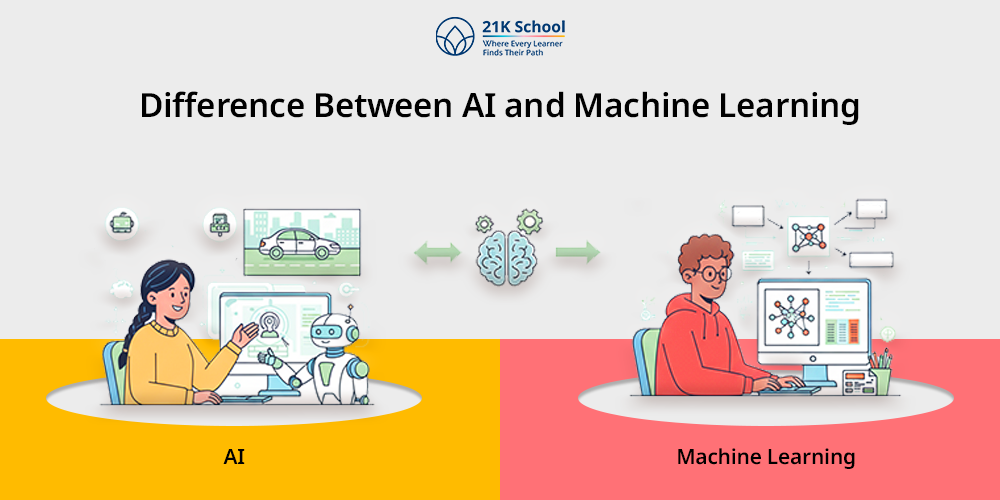
AI and, by the same, the concept of Machine Learning are two concepts that cannot be separated, however, have you ever thought about how they are altered?
Machine Learning and Artificial Intelligence are two rather similar terms that are closely related but not identical in the sphere of computer science.
Explore artificial intelligence in education .
Machine learning is a branch of AI – example-based algorithms. More easily described as AI, intelligent devices that mimic human intelligence are far more common. Machine learning is not a novel concept but they previously applied statistical approaches in implementing new technologies/programs.
Different technologies in learning such as AI and Machine learning ensure that learning is flexible and personalised to students. AI deals with intelligent machines and ML deals with the search of patterns in data.
Contents
What is Artificial Intelligence?
AI refers to the application of machines with human technology. By using AI, computers and software can do tasks normally necessitating that humans reason: learning through experience, pattern recognition, decision-making , and problem-solving .
Unlike in the traditional learning programming where all the rules are set in advance, AI systems learn and change their behaviour in response to change. Although AI is mostly referred to as the methods and instruments of learning, it also involves the algorithms, an immense volume of information, and an ever-growing computing power, which is now accessible on smartphones.
The interplay of AI with other technologies within the education sector has fostered support to both the learners and the teachers. The idea of machines that will be able to simulate human reasoning was first introduced by John McCarthy during the Dartmouth Conference in 1956.
Today, AI is implemented in different fields: it may be used in medicine, education, self-driving cars, and bank management to mention a few. AI leads to innovation and optimization of processes and productivity.
What is Machine Learning?
Machine learning (ML) is an idea that allows computer systems to carry out tasks that are not programmed, after learning and improving over time by reading the data.
ML replaces fixed, programmed procedures. ML searches big data, identifies patterns/correlations and makes predictions/decisions using the acquired knowledge .
An ML system is more effective with larger amounts of data. ML has many applications in natural language processing, computer vision, speech recognition, email filtering, agriculture and medicine.
Unix was not written till 1969 at Bell Labs by Ken Thompson and Dennis Ritchie, 17 years after Samuel had written his program. It is what he referred to as machine learning; computers that learn without being told to learn.
It is up to you whether to use machine learning as a supervised or unsupervised on labelled data. Unsupervised learning will identify patterns in data that are not labeled – e.g. reinforcement learning through learning by trial and error by use of rewards/punishments.
Difference Between AI and Machine Learning
Artificial intelligence is the pursuit of making things better and machine learning is a sub-field of AI that assists in making things learn and learn based on the data without the need to be programmed. Details of AI and ML distinction lie herein.
| Aspect | Artificial Intelligence | Machine Learning |
| Definition | AI is an intelligence much higher than that of humans. AI creates a text on request and is able to learn on its own. | ML relies on algorithms in order to enable systems to learn without being programmed. |
| Usage | There are numerous applications of AI and they include automatic chatbots and programs. | ML is extensively applied in data analysis/prediction and data sets. |
| Approach | AI methodology is rule programming, search techniques, expert systems and symbolic reasoning. | The strategy of ML is statistical techniques and algorithms, which are applied to develop models. |
| Objective | The purpose of AI is to imitate human intelligence and perform on its own. | The purpose of Ml is to develop models that are trained on data entries and minimize prediction or classification errors through training on data. |
| Data Dependency | AI is much less concerned with the information and sometimes has a tendency to learn independently. | ML is extremely data intensive and needs data volumes to be trained. ML relies on big data to give orders. |
| Complexity | AI is a complex subject because of its sub-topics like robotics, natural language processing and computer vision. | ML is not so complex because it employs certain learning algorithms only. |
| Types | AI has various types, such as Narrow AI, General AI, Theoretical AI and Super AI | ML has a wide range of types such as Supervised Learning, Unsupervised learning, Semi-Supervised, Reinforcement learning, Deep Learning and so on. |
| Output | AI produces outputs like text, image or decision-making that act like human responses/actions | ML predicts, classes or recommendations on the basis of trained models, often with confidence scores |
| Application | The applications of AI are varied and include medical diagnostic tools, video games and other NPCs, algorithmic trading and autonomous vehicles in the financial industry, and technology in transportation. | ML is typically applied to data-centric tasks such as personalised recommendations, image recognition, such as face unlock on phones and many more. |
| Examples | Examples of AI are Virtual assistants like Siri or Alexa, AlphaGo and so on. | Examples of ML are Spam filtering in email-based medical diagnostics models and so on. |
1. Definition
AI: It is the modeling of human intelligence in the machines that cause things which would be thought of by humans, such as decision making , problem solving, perception / natural language understanding etc.
ML: In a second field of AI, computers also learned the patterns of data and were able to predict or make decisions without having to be programmed to handle every case. And that is to leave machines to learn from experience.
2. Usage
AI: Broad varieties of applications in which intelligent behavior must come to be automated: chatbots working with pre-written scripts, self-driving cars etc. It is applied anywhere the intelligence of human beings is simulated.
ML: Primarily applied to data analysis/prediction – e.g. to recommend products on e-commerce websites or to detect fraud in the banking sector. It collaborates with AI systems though it learns big datasets.
3. Objective
AI: AI is trying to replicate or surpass human intellectual abilities in whatever they do in order to develop systems that can reason, adapt and behave under complicated circumstances. It equally aims at attaining general intelligence or skill in specific activities.
ML: ML aims to work out models based on the data input that will gradually reduce the error in forecasts and classifications. Pattern recognition and refinements are required instead of general intelligence.
4. Approach
AI: Rule-based programming, search algorithms, expert systems and symbolic reasoning. And it can be knowledge based (with pre-established rules) or data-based but tends to hard-coded logic to achieve certain results.
ML: Statistical training of models. It relies on supervised learning on labeled data, unsupervised learning on concealed patterns and reinforcement learning on trials and errors on data as opposed to manual rules.
5. Data Dependency
AI: It can be used to work with very little data in the event that we can have clear rules or logic as in the case of games such as chess that have fixed strategies. However, currently, we are witnessing the fact that modern AI is not necessarily data-driven.
ML: High user of large high quality sets of data to train. The absence of adequate data models fails to learn at all and hence data collection, cleaning, and preprocessing is a monumental problems.
6. Complexity
AI: Artificial Intelligence is a more complex one due to the various subfields: robotics, NLP and computer vision. AI is fully automated, costly in terms of calculations and requires numerous technologies.
ML: When big data is considered, hyperparameter tuning and scaling the models, the process of machine learning is more complex. Nonetheless, it is simpler on the specific issues, and more difficult on sophisticated deep learning methods .
7. Types
AI: Generally divided into Narrow AI – task oriented such as voice assistants – General AI has humanoid flexibility yet theoretical knowledge – and Super AI. There are those that are reactive and have no memory or low memory and self-awareness.
ML: They can be classified as Supervised Learning, predictive modelling with labelled data, Unsupervised learning including clustering and pattern discovery without labels, Semi-Supervised learning involving a combination of labelled/unlabeled data as well as Reinforcement learning, reward-based Learning. Deep Learning neural networks and Ensemble Methods, which integrate models are considered subsets.
8. Output
AI: Generates outputs such as text, image or decision-making that can be likened to the human response/actions. Deterministic (fixed rule) and probabilistic It is possible that in other systems the outputs are deterministic (fixed rules) or probabilistic.
ML: Makes predictions, classes or suggestions based on the trained models, and, in many cases, confidence scores. There are also improvements in outputs as we increase in the data but the uncertainties are possible when the model is applied in untrained situations.
9. Application
AI: It is applied in healthcare diagnostic programs, entertainment game NPCs, and automates/improves finance algorithmic trading and transport autonomous vehicles. It is the foundation of intelligent ecosystems such as smart cities.
ML: ML is typically applied in data-oriented applications such as personalised learning recommendations, image recognition, such as face unlock on phones, predictive maintenance, manufacturing sensors and sentiment analysis of social media monitoring. It does the learning in most applications of AI.
10. Examples
AI: Virtually, assistants such as Siri and Alexa also respond to voice instructions. Or think of business automation systems and AI gaming such as AlphaGo that plays and competes with human beings in the strategic board game Go.
ML: Medical diagnosis and diseases that are detected in X-Ray imaging, such as pneumonia; spam filtering in email messages with help of user marking and diagnostic support in X-Ray imaging to detect pneumonia.
Learn about benefits of artificial intelligence in education .
Conclusion
AI is a generational age of machines; machine learning is a section of AI which permits the machines to learn through information without being programmed.
AI will be a general objective of intelligent systems. ML can be one such algorithm that will make predictions based on the patterns of information.
AI deals with intelligent behaviour in tasks, whereas ML deals with predicting and learning data-driven. Systems are becoming smarter, more adaptive and more autonomous with both technologies in the education
/healthcare and finance/entertainment. To apply their differences to the problems of real life, this knowledge is useful.



